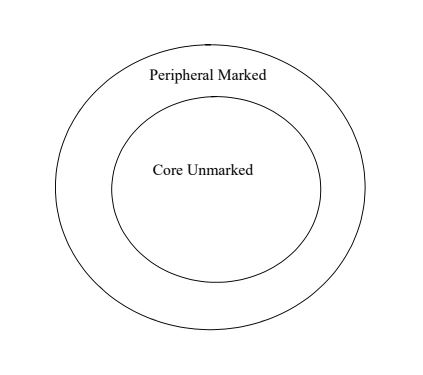Another fundamental concept in UG is core and peripheral grammars. Core grammars are those parts of the language that have grown in the child through the interaction of UG with the relevant language environment .Peripheral grammars are those parts of language that are not constrained by UG.
Chomsky advanced the idea that each sentence in a language has two levels of representation; a deep structure and a surface structure. The deep structure represented the core semantic relations of a sentence and was mapped on to the surface structure via transformations. Let’s look at the following sentences:
1. Ben ate the fruits
2. The fruits were eaten by Ben
The first sentence is called an active sentence focusing on what Ben did and the second one is a passive sentence focusing on what was done to the fruit but both of them are the same and the only difference between them lies in their surface structure. Sentence 2 reveals the surface structure. Sentence 1 reveals the underlying level where the basic components (Noun phrase +verb phrase +noun phrase) shared by the two sentences can be represented is their deep structure. The deep structure is an abstract level of structural organization in which all elements determining structural interpretation are represented (Yule G 2006). Thus the deep structure represents the core grammar.
Chomsky believed that there would be considerable similarities between the deep structures of languages and that these structures would reveal properties common to all languages which were concealed by their surface structures.
According to Chomsky the rules that the child discovers in a language with the help of UG form the core grammar of his language, not all rules are core rules. Every language also contains elements that are not constrained by UG. These elements comprise the peripheral grammar. Usually the peripheral rules are those that are derived from the history of a language. Sometimes elements of the peripheral grammar may have been borrowed into a language from other languages or may have arisen accidentally. Thus the child’s knowledge of the mother tongue is made up of rules determined by UG (the core) and those that have to be learnt without the help of UG (the periphery).
(Literary articles.blogspot.com/2012/10what-is-co-grammar-and-peripheral-grammar-in-html.)
Elements of core grammar are generally unmarked while those of peripheral grammars are marked. The unmarked elements are those with a wider range of distribution than the marked ones. Example: The English articles a and an
a unmarked
an marked
Of the two articles an is marked it is the more complex or marked form because it has an additional sound and a is the unmarked form with a wider distribution (Eckman 1977)
This distinction can be schematized as follows:

Marked items are those that are unusual/strange or unexpected, unmarked ones are usual.
According to Eckman (1981) marked items in a language are more difficult to acquire than unmarked, and degrees of markedness will correspond to degrees of difficulty; in other words, the more the markedness the more difficult it is to learn that language. In fact markedness theory advanced by Eckman (1977) has been used by some researchers to explain why there seems to be a certain order of acquisition of morphemes in English.
Marked structures are acquired later than unmarked ones Rutherford ( in Brown 1993) It is argued that core grammar is easier to acquire because it is the result of triggering data interacting with built-in principles and parameters, whereas peripheral phenomena actually have to be learnt therefore peripheral grammar is relatively more difficult to acquire.
One of the main aims of SLL research is to determine if a given linguistic parameter can be reset and if so how it can be reset .Take for example where a learner with Kiswahili as LI is learning English as L2. He will have to reset his parameter because as early pointed out English NPs place the specifier on the left hand while Kiswahili NPs place the specifier on the right hand. He will therefore have to learn to place specifiers on the left when he is communicating in English. Let’s have a look at the following sentences:
ENGLISH KISWAHILI
Hot tea Chai moto
Cold water Maji baridi
Specifier head Head specifier
In these examples the Kiswahili learner of English must begin to change the rule he is used to in Kiswahili to accommodate the rule of English .In other words he has to reset the parameters.
francis1897 answered the question on
March 9, 2023 at 06:04